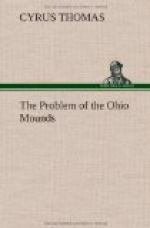The passage already quoted from Cusick’s narrative informs us that the contest lasted “perhaps one hundred years.” In close agreement with this statement the Delaware record makes it endure during the terms of four head-chiefs, who in succession presided in the Lenape councils. From what we know historically of Indian customs the average terms of such chiefs may be computed at about twenty-five years. The following extract from the record [Footnote: The Bark Record of the Leni Lenape.] gives their names and probably the fullest account of the conflict which we shall ever possess:
“Some went to the East, and the Tallegwi killed a portion.
“Then all of one mind exclaimed, War! War!
“The Talamatan (not-of-themselves) and the Nitilowan [allied north-people] go united (to the war).
“Kinnepehend (Sharp-Looking) was the leader, and they went over the river. And they took all that was there and despoiled and slew the Tallegwi.
“Pimokhasuwi (Stirring-about) was next chief, and then the Tallegwi were much too strong.
“Tenchekensit (Open-path) followed, and many towns were given up to him.
“Paganchihiella was chief, and the Tallegwi all went southward.
“South of the Lakes they (the Lenape) settled their council-fire, and north of the Lakes were their friends the Talamatan (Hurons!).”
There can he no reasonable doubt that the Alleghewi or Tallegwi, who have given their name to the Allegheny River and Mountains, were the mound-builders.
This supposition brings the pressing hordes to the northwest of the Ohio mound-builders, which is the direction, Colonel Force concludes, from the geographical position of the defensive works, they must have come.
The number of defensive works erected during the contest shows it must have been long and obstinate, and that the nation which could thus resist the attack of the northern hordes must have been strong in numbers and fertile in resources. But resistance proved in vain; they were compelled at last, according to the tradition, to leave the graves of their ancestors and flee southward in search of a place of safety.




